IRAN’S TOMB: Heirs of Persian Jews prize site that’s tied to Esther and Mordechai
I first learned of the burial place of Mordechai and Esther from an Iranian immigrant with whom I worked back in 1996. “Robbie” would tell me many stories about his family’s brave escape from Iran to America in the early 1980s, occasionally shedding a tear when speaking about his relatives and friends who were left behind in a country so hateful to the few remaining Jews.
But when the holiday of Purim rolled around, Robbie would liven up with tales from his youth. He’d tell us what it was like to celebrate Purim in Persia — the place where it all took place.
At the centerpiece of Robbie’s Purim stories was a tradition I’d never heard of, at a place I never knew existed – an annual gathering at the tomb of Mordechai and Esther to hear the reading of the Megilah. Robbie would describe in vivid detail the festive nature in which hundreds of Iranian Jews would flock — many in costume — to hear the story of Queen Esther beneath the dome of her final resting place. And next to Esther, her Uncle Mordechai, the man who guided her in a valiant attempt to save the Jews of Persia from extinction more than 2,000 years ago.
“But we never learned about this place in yeshiva,” I protested. “And it’s not mentioned in the Megilah. We’ve all heard about the Tomb of Rachel, the Tomb of King David. But the tomb of Esther?”
“That’s probably because none of your teachers ever visited Iran,” Robbie shot back. “Since the 1979 revolution, and even before that, Iran hasn’t exactly been a great place for Jewish tourism.
“Israel? Everyone’s been there. But Iran? Jews have had a horrible time getting out for so long; getting in really isn’t an option. But still, Iran is Persia, or Shushan from ancient times. Lots of Jewish history there. The tomb of Esther is probably the most important of these places.”
Indeed, for centuries, the Jews of Iran have been flocking to the Tomb of Esther, located in the city of Hamadan. And not just for Purim. Bris’s, bar mitzvahs, weddings and other religious rituals have taken place at this historic shrine. From the outside, this stone structure appears as though it dates back many centuries.

 66.0°,
Shallow Fog
66.0°,
Shallow Fog 







